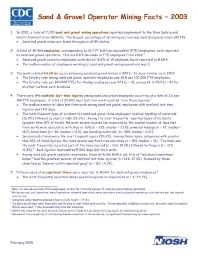Mining Publication: Sand and Gravel Operator Mining Facts - 2003
Original creation date: February 2005
Authors: National Institute for Occupational Safety and Health
NIOSHTIC2 Number: 20025916
U.S. Department of Health and Human Services, Public Health Service, Centers for Disease Control and Prevention, National Institute for Occupational Safety and Health, DHHS (NIOSH) Publication No. 2005-120, 2005 Feb; :1 pp
In 2003, a total of 7,070 sand and gravel mining operations reported employment to the Mine Safety and Health Administration (MSHA). The largest percentage of all mining sectors was sand and gravel mines (49.1%). A total of 35,966 employees, corresponding to 32,477 full-time equivalent (FTE) employees, were reported by sand and gravel operators. This is a 0.8% decrease in FTE employees from 2002. Ten work-related fatalities occurred among sand and gravel miners in 2003, the same number as in 2002. There were 846 nonfatal lost-time injuries among sand and gravel employees occurring at a rate of 2.6 per 100 FTE employees. A total of 39,843 days lost from work resulted from these injuries. Fifteen cases of occupational illness were reported to MSHA for sand and gravel employees.

NIOSHTIC2 Number: 20025916
U.S. Department of Health and Human Services, Public Health Service, Centers for Disease Control and Prevention, National Institute for Occupational Safety and Health, DHHS (NIOSH) Publication No. 2005-120, 2005 Feb; :1 pp
- Coal and metal/nonmetal mining facts - 2008
- Coal and Metal/Nonmetal Mining Facts - 2008 (HTML)
- Coal Contractor Mining Facts - 2001
- Coal Contractor Mining Facts - 2002
- Coal Contractor Mining Facts - 2003
- Coal Contractor Mining Facts - 2004
- Coal Contractor Mining Facts - 2005
- Coal Contractor Mining Facts - 2006
- Mining Fact Sheets
- Rib Falls: A Major Ground Control Issue